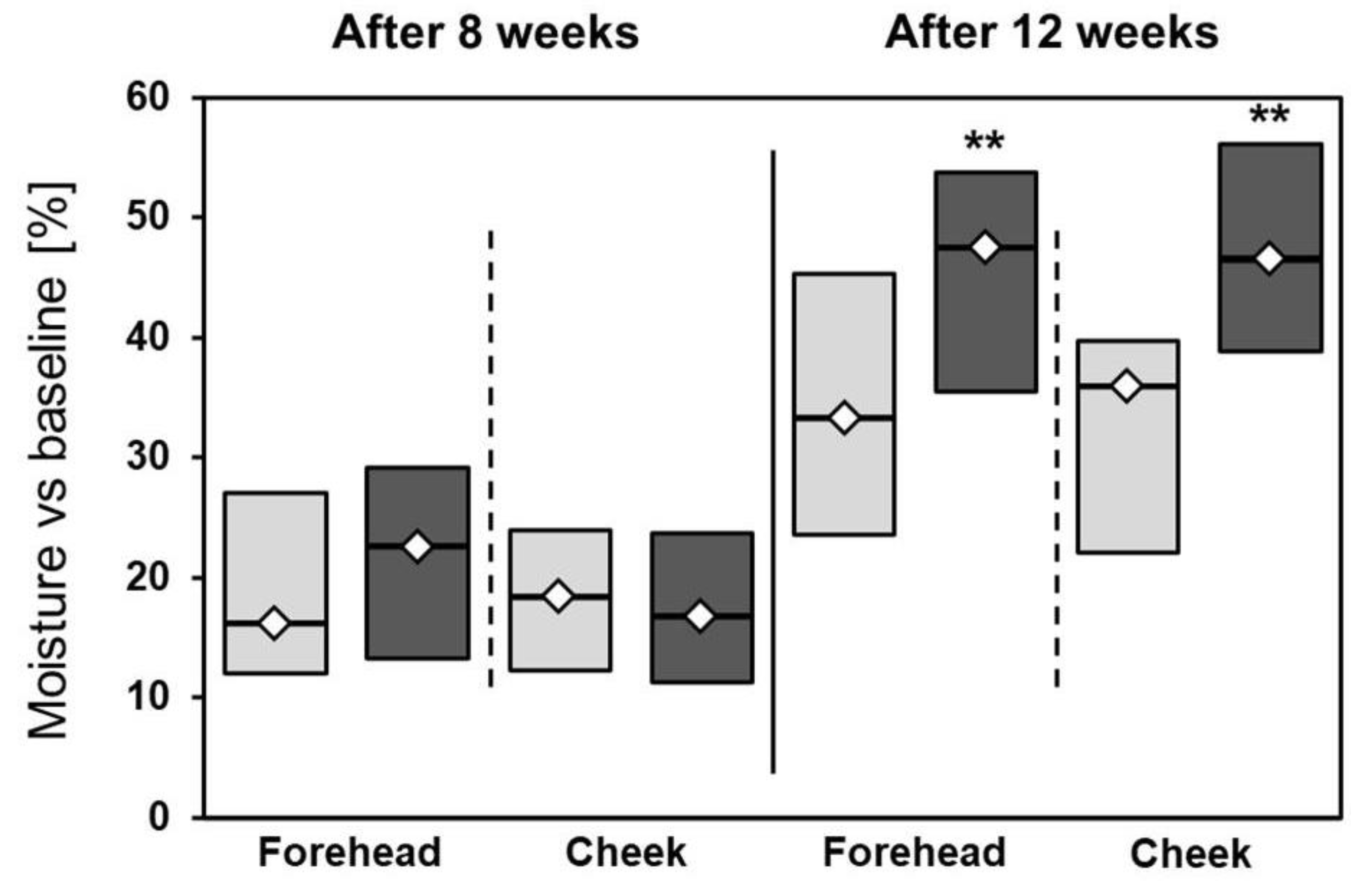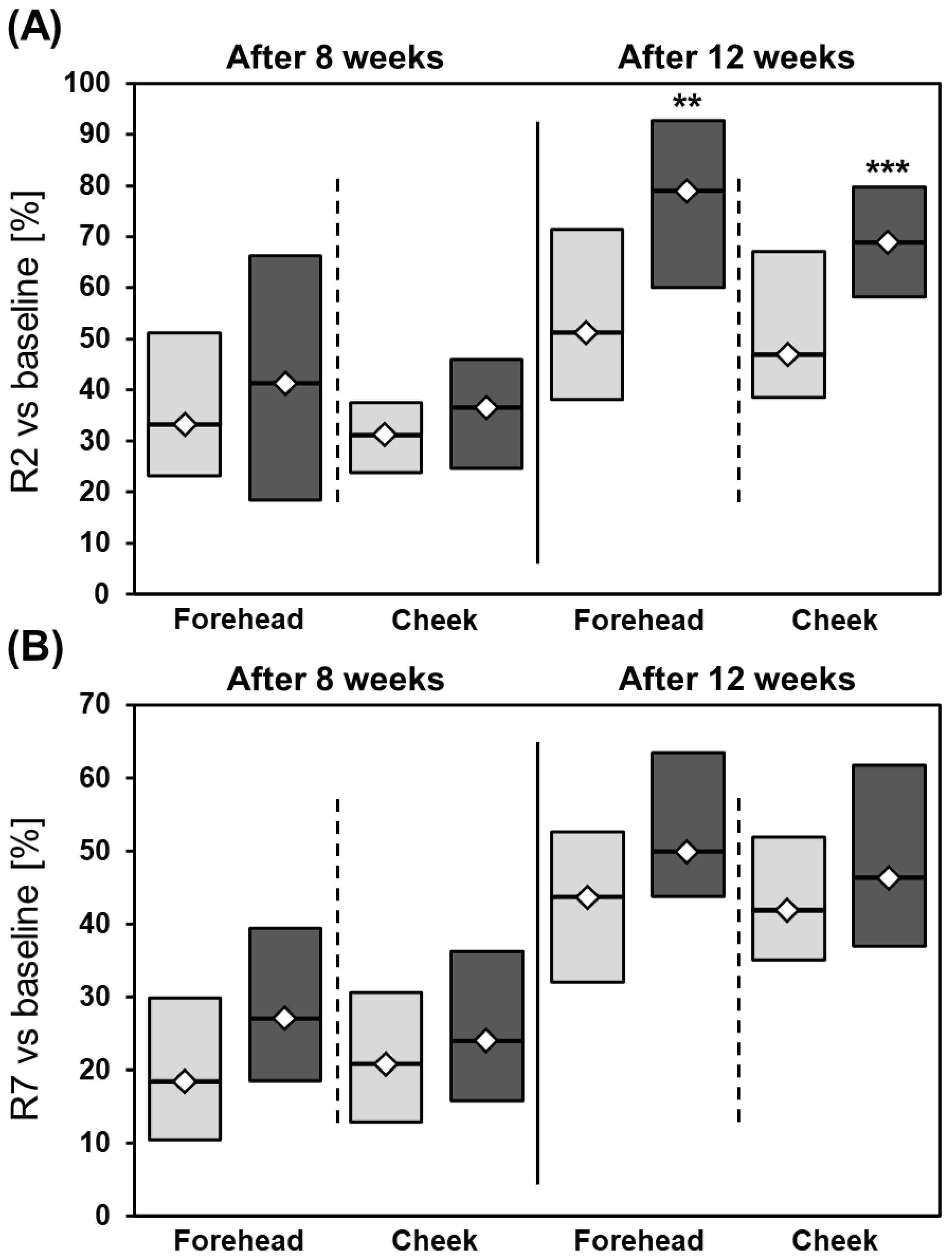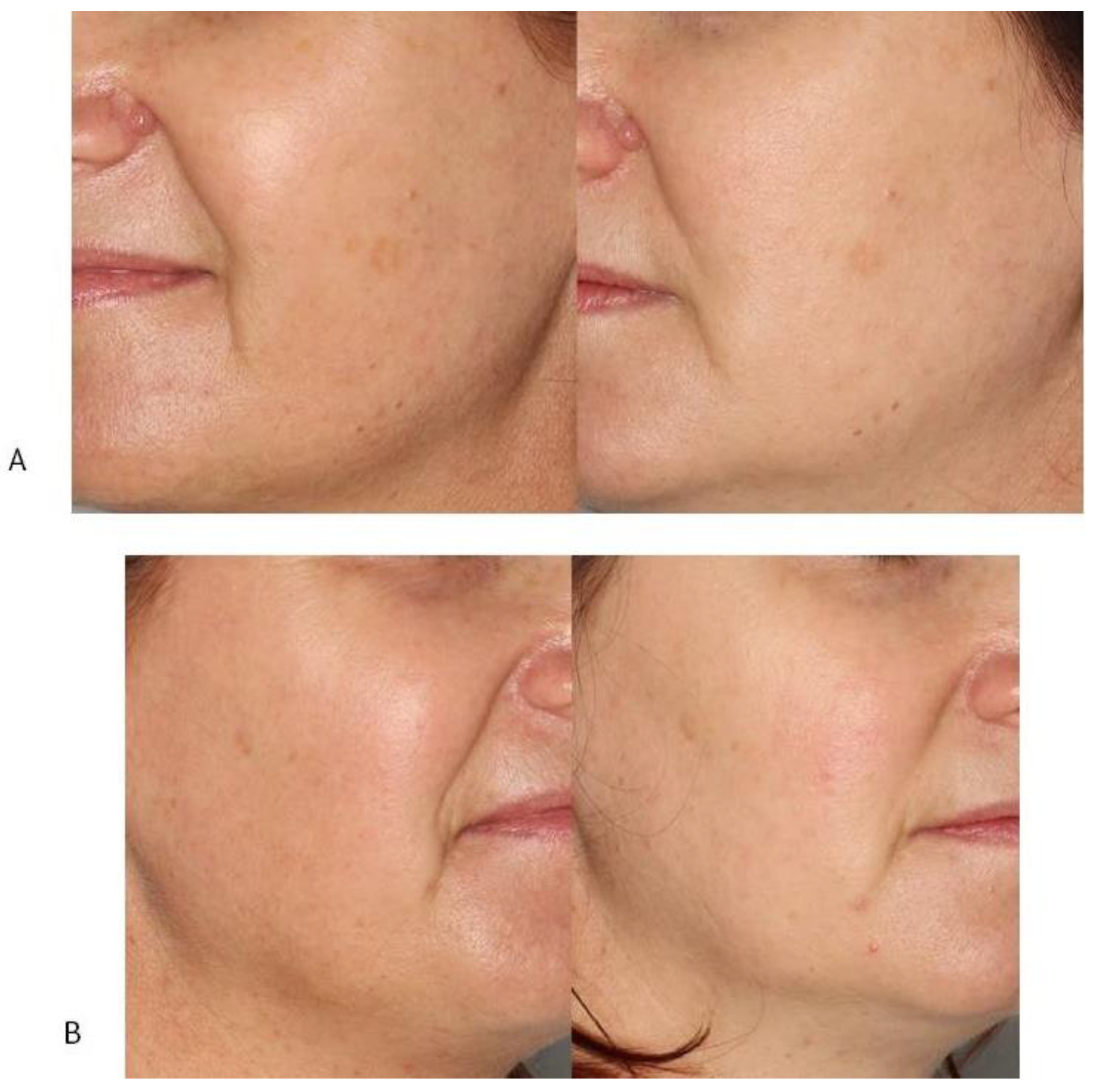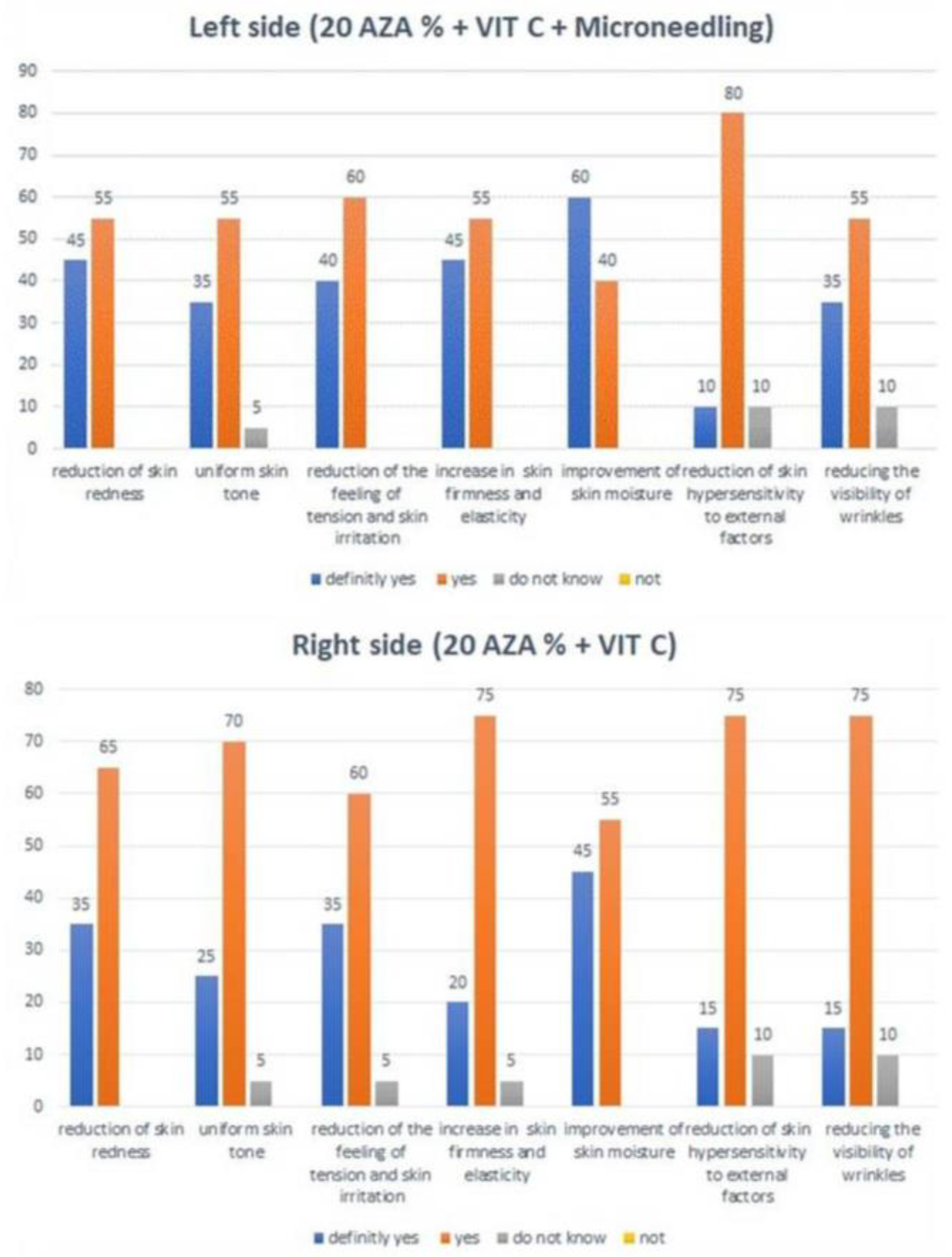A Subjective and Objective Assessment of Combined Methods of Applying Chemical Peels and Microneedling in Antiaging Treatments
Abstract
1. Introduction
2. Materials and Methods
2.1. Participants
2.2. Procedures
2.3. Measurement of Skin Parameters
2.4. Statistical Analysis
3. Results
4. Discussion
5. Conclusions
Author Contributions
Funding
Institutional Review Board Statement
Informed Consent Statement
Data Availability Statement
Acknowledgments
Conflicts of Interest
References
- Wadstein, J.; Alvarez, I.S.; López, L.B. Managing Skin Ageing as a Modifiable Disorder—The Clinical Application of Nourella® Dual Approach Comprising a Nano-Encapsulated Retinoid, Retilex-A® and a Skin Proteoglycan Replacement Therapy, Vercilex®. Cosmetics 2022, 9, 31. [Google Scholar] [CrossRef]
- Zhang, S.; Duan, E. Fighting against Skin Aging: The Way from Bench to Bedside. Cell Transplant. 2018, 27, 729–738. [Google Scholar] [CrossRef]
- Huertas, A.C.M.; Schmelzer, C.E.; Hoehenwarter, W.; Heyroth, F.; Heinz, A. Molecular-level insights into aging processes of skin elastin. Biochimie 2016, 128, 163–173. [Google Scholar] [CrossRef]
- Aldag, C.; Nogueira Teixeira, D.; Leventhal, P.S. Skin rejuvenation using cosmetic products containing growth factors, cytokines, and matrikines: A review of the literature. Clin. Cosmet. Investig. Dermatol. 2016, 9, 411–419. [Google Scholar] [CrossRef]
- Kammeyer, A.; Luiten, R. Oxidation events and skin aging. Ageing Res. Rev. 2015, 21, 16–29. [Google Scholar] [CrossRef]
- Bissett, D.L.; Johnson, M.B. Cosmetic Anti-aging Ingredients. In Textbook of Aging Skin; Farage, M.A., Miller, K.W., Maibach, H.I., Eds.; Springer: Berlin/Heidelberg, Germany, 2010; pp. 1069–1078. [Google Scholar]
- Pullar, J.M.; Carr, A.C.; Vissers, M.C.M. The Roles of Vitamin C in Skin Health. Nutrients 2017, 9, 866. [Google Scholar] [CrossRef]
- Geesin, J.C.; Darr, D.; Kaufman, R.; Murad, S.; Pinnell, S.R. Ascorbic acid specifically increases type I and type III procollagen messenger RNA levels in human skin fibroblasts. J. Investig. Dermatol. 1988, 90, 420–424. [Google Scholar] [CrossRef]
- Tajima, S.; Pinnell, S.R. Ascorbic acid preferentially enhances type I and III collagen gene transcription in human skin fibroblasts. J. Dermatol. Sci. 1996, 11, 250–253. [Google Scholar] [CrossRef]
- Duarte, T.L.; Cooke, M.S.; Jones, G.D. Gene expression profiling reveals new protective roles for vitamin C in human skin cells. Free. Radic. Biol. Med. 2009, 46, 78–87. [Google Scholar] [CrossRef]
- Kishimoto, Y.; Saito, N.; Kurita, K.; Shimokado, K.; Maruyama, N.; Ishigami, A. Ascorbic acid enhances the expression of type 1 and type 4 collagen and SVCT2 in cultured human skin fibroblasts. Biochem. Biophys. Res. Commun. 2013, 430, 579–584. [Google Scholar] [CrossRef]
- Hinek, A.; Kim, H.J.; Wang, Y.; Wang, A.; Mitts, T.F. Sodium L-ascorbate enhances elastic fibers deposition by fibroblasts from normal and pathologic human skin. J. Dermatol. Sci. 2014, 75, 173–182. [Google Scholar] [CrossRef]
- Marionnet, C.; Vioux-Chagnoleau, C.; Pierrard, C.; Sok, J.; Asselineau, D.; Bernerd, F. Morphogenesis of dermal–epidermal junction in a model of reconstructed skin: Beneficial effects of vitamin C. Exp. Dermatol. 2006, 15, 625–633. [Google Scholar] [CrossRef]
- Pasonen-Seppänen, S.; Suhonen, M.T.; Kirjavainen, M.; Suihko, E.; Urtti, A.; Miettinen, M.; Hyttinen, M.; Tammi, M.; Tammi, R. Vitamin C enhances differentiation of a continuous keratinocyte cell line (REK) into epidermis with normal stratum corneum ultrastructure and functional permeability barrier. Histochem. Cell Biol. 2001, 116, 287–297. [Google Scholar] [CrossRef]
- Gibson, J. Rationale for the development of new topical treatments for acne vulgaris. Cutis 1996, 57, 13–19. [Google Scholar]
- Wójcik, A.; Kubiak, M.; Rotsztejn, H. Influence of azelaic and mandelic acid peels on sebum secretion in ageing women. Postepy Dermatol. Alergol. 2013, 30, 140–145. [Google Scholar] [CrossRef]
- Prikhnenko, S. Polycomponent mesotherapy formulations for the treatment of skin aging and improvement of skin quality. Clin. Cosmet. Investig. Dermatol. 2015, 8, 151–157. [Google Scholar] [CrossRef]
- Meng, J.; Lv, Z.; Qiao, X.; Li, X.; Li, Y.; Zhang, Y.; Chen, C. The decay of redox-stress response capacity is a substantive characteristic of aging: Revising the redox theory of aging. Redox Biol. 2017, 11, 365–374. [Google Scholar] [CrossRef]
- Pourzand, C.; Albieri-Borges, A.; Raczek, N.N. Shedding a New Light on Skin Aging, Iron- and Redox-Homeostasis and Emerging Natural Antioxidants. Antioxidants 2022, 11, 471. [Google Scholar] [CrossRef]
- Green, A.; Hughes, M.; McBride, P.; Fourtanier, A. Factors associated with premature skin aging (photoaging) before the age of 55: A population-based study. Dermatology 2011, 222, 74–80. [Google Scholar] [CrossRef]
- Masaki, H. Role of antioxidants in the skin: Anti-aging effects. J. Dermatol. Sci. 2010, 58, 85–90. [Google Scholar] [CrossRef]
- Bergman, D.; Luke, J. Azelaic acid. J. Dermatol. Nurses’ Assoc. 2017, 9, 157–160. [Google Scholar] [CrossRef]
- Nautiyal, A.; Wairkar, S. Management of hyperpigmentation: Current treatments and emerging therapies. Pigment Cell Melanoma Res. 2021, 34, 1000–1014. [Google Scholar] [CrossRef] [PubMed]
- Mazurek, K.; Pierzchała, E. Comparison of efficacy of products containing azelaic acid in melasma treatment. J. Cosmet. Dermatol. 2016, 15, 269–282. [Google Scholar] [CrossRef] [PubMed]
- Hwang, S.W.; Oh, D.J.; Lee, D.; Kim, J.W.; Park, S.W. Clinical efficacy of 25% L-ascorbic acid (C’ensil) in the treatment of melasma. J. Cutan. Med. Surg. 2009, 13, 74–81. [Google Scholar] [CrossRef]
- Oresajo, C.; Stephens, T.; Hino, P.D.; Law, R.M.; Yatskayer, M.; Foltis, P.; Pillai, S.; Pinnell, S.R. Protective effects of a topical antioxidant mixture containing vitamin C, ferulic acid, and phloretin against ultraviolet-induced photodamage in human skin. J. Cosmet. Dermatol. 2008, 7, 290–297. [Google Scholar] [CrossRef] [PubMed]
- Murray, J.C.; Burch, J.A.; Streilein, R.D.; Iannacchione, M.A.; Hall, R.P.; Pinnell, S.R. A topical antioxidant solution containing vitamins C and E stabilized by ferulic acid provides protection for human skin against damage caused by ultraviolet irradiation. J. Am. Acad. Dermatol. 2008, 59, 418–425. [Google Scholar] [CrossRef] [PubMed]
- Kameyama, K.; Sakai, C.; Kondoh, S.; Yonemoto, K.; Nishiyama, S.; Tagawa, M.; Murata, T.; Ohnuma, T.; Quigley, J.; Dorsky, A.; et al. Inhibitory effect of magnesium L-ascorbyl-2-phosphate (VC-PMG) on melanogenesis in vitro and in vivo. J. Am. Acad. Dermatol. 1996, 34, 29–33. [Google Scholar] [CrossRef] [PubMed]
- Algiert-Zielińska, B.; Mucha, P.; Rotsztejn, H. Effects of lactobionic acid peel, aluminum oxide crystal microdermabrasion, and both procedures on skin hydration, elasticity, and transepidermal water loss. J. Cosmet. Dermatol. 2019, 18, 1463–1474. [Google Scholar] [CrossRef] [PubMed]
- Matthews-Brzozowska, T.; Łącka, M.; Bernacka, M.; Lichaj, M. Mesotherapy—A method of facial skin rejuvenation from an interdisciplinary perspective on improving facial aesthetics. J. Med. Sci. 2017, 86, 308–312. [Google Scholar] [CrossRef]
- Dobrev, H. In vivo study of skin mechanical properties in Raynaud’s phenomenon. Skin Res. Technol. 2007, 13, 91–94. [Google Scholar] [CrossRef]
- Jung, G.S.; Eom, J.R.; Jeon, H.J.; Chu, S.G.; Oh, E.; Lee, J.W. Facial Rejuvenating Effects of Mesotherapy Using a New Polycomponent Formulation. Med. Lasers 2018, 7, 69–73. [Google Scholar] [CrossRef]
- Tedeschi, A.; Lacarrubba, F.; Micali, G. Mesotherapy with an Intradermal Hyaluronic Acid Formulation for Skin Rejuvenation: An Intrapatient, Placebo-Controlled, Long-Term Trial Using High-Frequency Ultrasound. Aesthetic Plast. Surg. 2015, 39, 129–133. [Google Scholar] [CrossRef] [PubMed]
- Humbert, P.L.L.; Saas, P.; Viennet, C. Vitamin C, Aged Skin, Skin Health. In Vitamin C—An Update on Current Uses and Functions; IntechOpen: London, UK, 2018. [Google Scholar] [CrossRef]
- Sauermann, K.; Jaspers, S.; Koop, U.; Wenck, H. Topically applied vitamin C increases the density of dermal papillae in aged human skin. BMC Dermatol. 2004, 4, 13. [Google Scholar] [CrossRef]
- Humbert, P.G.; Haftek, M.; Creidi, P.; Lapière, C.; Nusgens, B.; Richard, A.; Schmitt, D.; Rougier, A.; Zahouani, H. Topical ascorbic acid on photoaged skin. Clinical, topographical and ultrastructural evaluation: Double-blind study vs. placebo. Exp. Dermatol. 2003, 12, 237–244. [Google Scholar] [CrossRef]
- Raschke, T.; Koop, U.; Düsing, H.J.; Filbry, A.; Sauermann, K.; Jaspers, S.; Wenck, H.; Wittern, K.P. Topical activity of ascorbic acid: From in vitro optimization to in vivo efficacy. Skin Pharmacol. Physiol. 2004, 17, 200–206. [Google Scholar] [CrossRef]
- Fitzpatrick, R.E.; Rostan, E.F. Double-blind, half-face study comparing topical vitamin C and vehicle for rejuvenation of photodamage. Dermatol. Surg. 2002, 28, 231–236. [Google Scholar] [CrossRef]
- Chilicka, K.; Rogowska, A.M.; Szyguła, R.; Dzieńdziora-Urbińska, I.; Taradaj, J. A comparison of the effectiveness of azelaic and pyruvic acid peels in the treatment of female adult acne: A randomized controlled trial. Sci. Rep. 2020, 10, 12612. [Google Scholar] [CrossRef]








| Skin Tone N = 20 | Site of Measurement | Time Point | p | ||
|---|---|---|---|---|---|
| Measurement I Baseline (*) | Measurement II 8 Weeks (#) | Measurement III 12 Weeks | |||
| Left side (A + 10%Vit C + M) | Forehead | 144.0 ± 17.5 | *** 116.6 ± 20.9 | *** 108.8 ± 19.2 ### | p < 0.0001 |
| Cheek | 133.4 ± 19.7 | *** 103.8 ± 24.8 | *** 96.5 ± 21.2 ### | p < 0.0001 | |
| Right side (A + 40% Vit C) | Forehead | 143.5 ± 15.0 | *** 117.7 ± 22.2 | *** 109.8 ± 23.3 # | p < 0.0001 |
| Cheek | 130.0 ± 14.3 | *** 108.6 ± 19.1 | *** 102.9 ± 18.0 ### | p < 0.0001 | |
| Erythema N = 20 | Site of Measurement | Time point | p | ||
|---|---|---|---|---|---|
| Measurement I (*) | Measurement II (#) | Measurement III | |||
| Left side (A + 10%Vit C + M) | Forehead | 336.0 ± 44.3 | *** 270.5 ± 47.3 | *** 234.0 ± 29.2 ### | p < 0.0001 |
| Cheek | 354.5 ± 51.7 | *** 294.6 ± 50.2 | *** 255.3 ± 44.1 ### | p < 0.0001 | |
| Right side (A + 40% Vit C) | Forehead | 331.2 ± 47.8 | *** 268.4 ± 47.5 | *** 243.0 ± 35.5 ### | p < 0.0001 |
| Cheek | 343.6 ± 51.0 | *** 285.7 ± 50.2 | *** 250.7 ± 46.0 ### | p < 0.0001 | |
| Hydration N = 20 | Site of Measurement | Time point | p | ||
|---|---|---|---|---|---|
| Measurement I (*) | Measurement II (#) | Measurement III | |||
| Left side (A + 10%Vit C + M) | Forehead | 45.7 ± 6.6 | *** 56.9 ± 9.1 | *** 67.6 ± 7.3 ### | p < 0.0001 |
| Cheek | 45.5 ± 4.8 | *** 53.1 ± 6.3 | *** 66.7 ± 5.1 ### | p < 0.0001 | |
| Right side (A + 40% Vit C) | Forehead | 46.2 ± 6.5 | *** 54.4 ± 7.6 | *** 61.0 ± 7.4 ### | p < 0.0001 |
| Cheek | 45.5 ± 4.7 | *** 54.2 ± 6.4 | *** 60.6 ± 7.1 ### | p < 0.0001 | |
| R2 | Site of Measurement | Time Point | p | ||
|---|---|---|---|---|---|
| Measurement I (*) | Measurement II (#) | Measurement III | |||
| Left side (A + 10% Vit C + M) | Forehead | 0.440 ± 0.035 | *** 0.632 ± 0.112 | *** 0.786 ± 0.095 ### | p < 0.0001 |
| Cheek | 0.457 ± 0.031 | *** 0.616 ± 0.066 | *** 0.776 ± 0.044 ### | p < 0.0001 | |
| Right side (A + 40% Vit C) | Forehead | 0.465 ± 0.057 | *** 0.626 ± 0.089 | *** 0.704 ± 0.052 ### | p < 0.0001 |
| Cheek | 0.460 ± 0.048 | *** 0.596 ± 0.064 | *** 0.685 ± 0.059 ### | p < 0.0001 | |
| R7 | Site of Measurement | Time Point | P | ||
|---|---|---|---|---|---|
| Measurement I (*) | Measurement II (#) | Measurement III | |||
| Left side (A + 10% Vit C + M) | Forehead | 0.274 ± 0.039 | *** 0.352 ± 0.045 | *** 0.420 ± 0.045 ### | p < 0.0001 |
| Cheek | 0.282 ± 0.036 | *** 0.361 ± 0.046 | *** 0.427 ± 0.039 ### | p < 0.0001 | |
| Right side (A + 40% Vit C) | Forehead | 0.294 ± 0.041 | *** 0.356 ± 0.056 | *** 0.426 ± 0.051 ### | p < 0.0001 |
| Cheek | 0.291 ± 0.032 | *** 0.354 ± 0.044 | *** 0.423 ± 0.036 ### | p < 0.0001 | |
Disclaimer/Publisher’s Note: The statements, opinions and data contained in all publications are solely those of the individual author(s) and contributor(s) and not of MDPI and/or the editor(s). MDPI and/or the editor(s) disclaim responsibility for any injury to people or property resulting from any ideas, methods, instructions or products referred to in the content. |
© 2023 by the authors. Licensee MDPI, Basel, Switzerland. This article is an open access article distributed under the terms and conditions of the Creative Commons Attribution (CC BY) license (https://creativecommons.org/licenses/by/4.0/).
Share and Cite
Markiewicz-Tomczyk, A.; Budzisz, E.; Erkiert-Polguj, A. A Subjective and Objective Assessment of Combined Methods of Applying Chemical Peels and Microneedling in Antiaging Treatments. J. Clin. Med. 2023, 12, 1869. https://doi.org/10.3390/jcm12051869
Markiewicz-Tomczyk A, Budzisz E, Erkiert-Polguj A. A Subjective and Objective Assessment of Combined Methods of Applying Chemical Peels and Microneedling in Antiaging Treatments. Journal of Clinical Medicine. 2023; 12(5):1869. https://doi.org/10.3390/jcm12051869
Chicago/Turabian StyleMarkiewicz-Tomczyk, Agata, Elzbieta Budzisz, and Anna Erkiert-Polguj. 2023. "A Subjective and Objective Assessment of Combined Methods of Applying Chemical Peels and Microneedling in Antiaging Treatments" Journal of Clinical Medicine 12, no. 5: 1869. https://doi.org/10.3390/jcm12051869
APA StyleMarkiewicz-Tomczyk, A., Budzisz, E., & Erkiert-Polguj, A. (2023). A Subjective and Objective Assessment of Combined Methods of Applying Chemical Peels and Microneedling in Antiaging Treatments. Journal of Clinical Medicine, 12(5), 1869. https://doi.org/10.3390/jcm12051869






